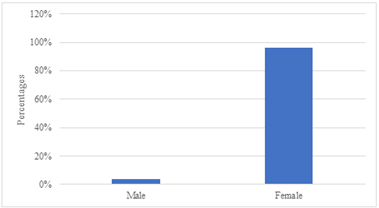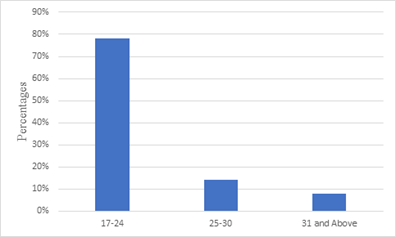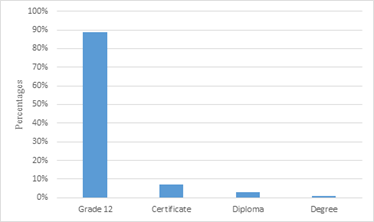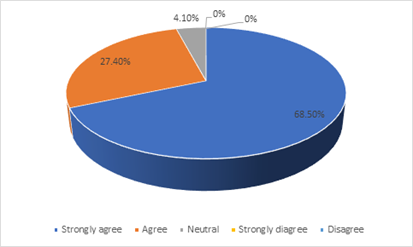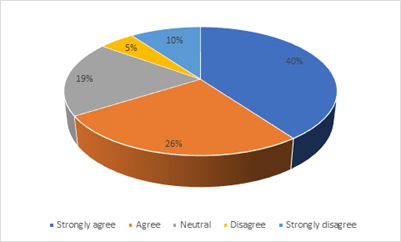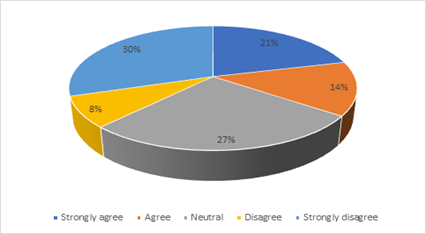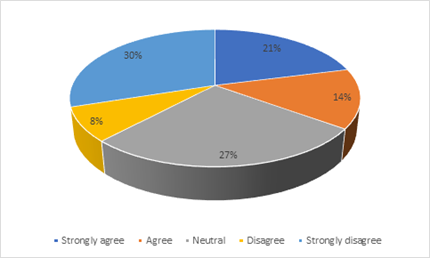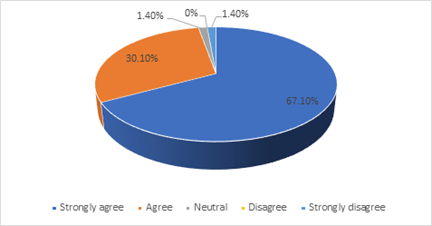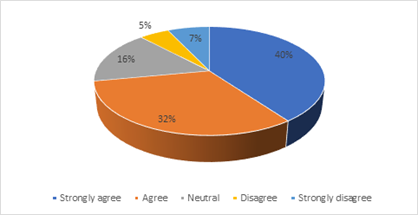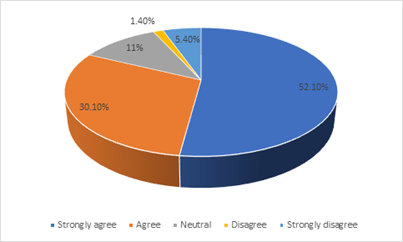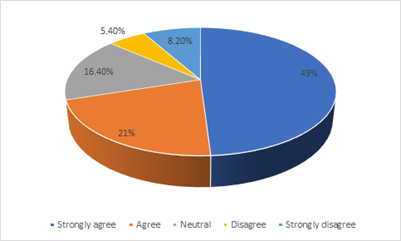Research Article
Assessment of Knowledge and Attitudes of 3rd Year Degree Nursing Students Regarding Unsafe Abortion at A University in Namibia
1University of Namibia.
2School of Nursing and Public Health, Faculty of Health Sciences and Veterinary Medicine, University of Namibia.
*Corresponding Author: Joseph Galukeni Kadhila, School of Nursing and Public Health, Faculty of Health Sciences and Veterinary Medicine, University of Namibia.
Citation: Petrus A, Joseph G Kadhila. (2023). Assessment of Knowledge and Attitudes of 3rd Year Degree Nursing Students Regarding Unsafe Abortion at A University in Namibia. International Clinical and Medical Case Reports, BRS Publishers. 1(1); DOI: https://www.doi.org/brs/2023/icmr/0002
Copyright: © 2023 Joseph Galukeni Kadhila, this is an open-access article distributed under the terms of the Creative Commons Attribution License, which permits unrestricted use, distribution, and reproduction in any medium, provided the original author and source are credited.
Received: December 28, 2022 | Accepted: January 16, 2023 | Published: January 23, 2023
Abstract
Background: Unsafe abortion has defined as a procedure of pregnancy terminated either by persons lacked the necessary skills or in an environment that does not conform to minimal medical standards or both. An estimation of 56.3 million abortions per year were reported globally, between 2010 and 2014. This showed that 25% of all pregnancies (1 out of 4) ended in abortion legally or illegally. In Namibia it is difficult to count abortion cases because, abortion is illegal, women do it secretly. The criminalisation of abortions has driven Namibians to unsafe abortion even though the contribution of unsafe abortion and maternal death is unknown, little data available suggested that it may account for 12 to 16% of Namibia’s annual maternal.
Method: The purpose of the study was to assess the knowledge and attitudes of nursing student at University of Namibia, Main Campus on Unsafe abortion. Hard copies questionnaires were distributed to 3rd years nursing degree students and primary data were obtained from students.
Results: A total number of 73 3rd year nursing degree students participated in the study from the University of Namibia, Main Campus. The majority of students were females 96% (70) and males were 4% (3). The majority of students shows that they have knowledge about unsafe abortion and have positive attitudes toward unsafe abortion.
Conclusion: Students are exposed to unsafe abortion in the clinical practice, and majority of them are aware of it. Therefore, it is crucial for students to get more lecturer before started with practical to have more knowledge and positive attitudes toward unsafe abortion.
Recommendations: this study proposed to the University of Namibia to review their nursing curriculum regarding unsafe abortion and emphasize more in order to prevent death among women of child bearing age.
Keywords: unsafe abortion; knowledge; attitudes and student nurses
Introduction
According to [11] has defined abortion as the termination of a pregnancy by removal or expulsion of an embryo or foetus before it had survived outside the uterus. Abortion is a procedure done to terminate a pregnancy, Namibian communities understood it as a killing or murder of an unborn baby. In Namibia, abortion is illegal. An abortion can have occurred spontaneously which has been called miscarriage or purposefully which has been called induced abortion.
[5] explained spontaneous abortion as a non-induce embryonic or foetal death or passage of product of conception before 20 weeks of gestation. It occurred for many reasons include diseases, trauma, genetic defect or biochemical incompatibility of mother and foetus.
Induced abortion is any abortion that performed to preserve the well-being of the female or in cases of rape or incest. This abortion is done to preserve the life or physical or mental well-being of the mother, to prevent the completion of a pregnancy that has resulted from rape or incest, to prevent the birth of a child with serious deformity, mental deficiency or genetic abnormalities or to prevent a birth for social or economic reasons such as the extreme youth of the pregnant female [4].
In America, 30% women likely to had an abortion by the time they reached 45 years of age. During 2010-2014 an estimation of 6.5millions induced abortion occurred each year in Latin America and 4.4 million in Caribbean in 1990-1994.The annual rate of abortion is estimated at 44 per 1000,women of reproductive age (15-44)as slightly increased from 40 per 1000 in 1990-1994.In sub region 33 per 1000 in South America to 59 per 1000 in Caribbean .About 78 000 women in America are treated for complication from unsafe abortion .In 2014 ,at least 10%of all maternal death (900 deaths)in Latin America and Caribbean were from unsafe abortion [13].
In Africa, Malawi has one of the highest maternal mortality rates in the world, estimated at 510 maternal deaths per 100000 per lives births, which 10% attributed to unsafe abortion. Educated women are more likely to seek unsafe abortion than counterparts [9].
In Namibia, in 2016 alone Dr Bernard Haufiku pointed out that 7335 illegal cases of abortion were recorded at state facilities and it could reach 10000 since many cases involves women aged below 25 years goes unreported. Intermediate Katutura Hospital with highest 1503 cases followed by Windhoek Central Hospital with 878 cases of abortion. Oshakati State Hospital, 766: Onandjokwe Lutheran Hospital ,621: Rundu State Hospital,419: Outapi State Hospital ,405: Swakopmund State Hospital, 329: WalvisBay State Hospital ,302: Otjiwarongo state Hospital ,246: Katima Mulilo State Hospital ,201: Gobabis State Hospital ,174: Engela State Hospital,126: Rehoboth State Hospital,121:and Okahao State Hospital with 105 cases, and out of these cases (7335), 138 were medical abortion (authorized cases) which is only 2% constitutes of the total. Abortion in Namibia is still illegal unless is done under Namibian law (Abortion and Sterilization Act 2 of 1975) which is inherited from South Africa. Unsafe abortion is a major concern on health system, student needs to have knowledge about it, in order to save the women lives and to prevent further complications and maternal death among women practicing unsafe abortion [15].
Background of the study
According to (8), an estimation of 56.3 million abortions per year were reported globally, between 2010 and 2014. This shows that 25% of all pregnancies (1 out of 4) ended in abortion legally or illegally. However, 121 million unplanned pregnancies have occurred each year between 2015 and 2019. About 61% of all unplanned pregnancies less than 2 or 3 ends in abortion. Globally, unsafe abortion is account for 8-11% of maternal mortality annually, which translate to the death of some 23000-31000 women yearly.
In Africa, over 4 million unsafe abortions are carried out yearly highly in poor, rural, and young women who are lack information on availability of safe abortion care. 99% of unsafe abortion resulted in one maternal death per 150 cases. In Sub –Sahara, unsafe abortion is more common and it tends to be clandestine and unsafe that is substantially contributed to maternal death that were 37 deaths per 100000 live births. Unsafe abortions are practised using different methods such as use of oral and injectable items, vaginal preparation, intrauterine foreign bodies, and trauma to the abdomen. These leads to complications such as haemorrhage, sepsis, peritonitis, trauma to cervix, vagina, uterus and abdominal organs and hospitalisation [6].
In Namibia it is difficult to count abortion cases because, abortion is illegal, women do it secretly. Report of illegal/unsafe abortion in Namibia indicated that in 2013-2015 it was declining because in 2013 there were only [23] cases, 2014 [19] cases and 2015 [13] cases and from (2016-2019) it started to raised again as it was reported that in 2016 there were (26) cases, 2017(19) cases, 2018 [18] cases and in 2019 there were [29] cases. However, in June 2020 Namibians wrote a petition that wanted a law to increase access to legal abortion and it has attracted over 60000 signatures by September 2020 but it was not liberalise due strong opposition from religious group and some women’s groups and politicians. Women who could afford abortion travellers to South Africa to access legal abortion services (abortion has been available on request during the 1st 12 weeks of gestation in South Africa since 1996). The criminalisation of abortions has driven Namibians to unsafe abortion even though the contribution of unsafe abortion and maternal death is unknown, little data available suggested that it may account for 12 to 16% of Namibia’s annual maternal death [8].
Purpose of the study
The purpose of the study was to assess the knowledge and attitudes of 3rd year degree nursing students regarding unsafe abortion, at University of Namibia, main campus.
Methodology
The researcher employed a quantitative descriptive design.
The research population total was 89 third-year nursing students registered for the Bachelor of Nursing Science (Clinical) Honours program at the University of Namibia Main campus in Khomas Region and 73 nursing students participated.
Data collection
As a means of gathering data for this study, the researcher created an English-language questionnaire. Three components made up the questionnaire. The first section A of the survey asked about demographic information like age and sex, the second section B asked about knowledge of unsafe abortion with Yes and No responses, and the third and final section C asked about attitudes toward unsafe abortion using a Likert scale with the options Strongly agree, Agree, Neutral, Disagree, and Strongly disagree.
Data analysis
The data was analysed through bivariate analysis using scientific package of social sciences (SPSS). The research findings were then presented in the form of graphs, tables and findings interpreted in the discussion section.
Ethical considerations
Approval to carry out the study was granted by the University of Namibia School of Nursing and Public, Faculty of Health Sciences and Veterinary Medicine and informed consent was given by the participants before data collection.
In this study, data were gathered from 73 third-year nursing students at UNAM's Main Campus using a quantitative cross-sectional design. Prior to the main investigation, a pilot study with four nursing students was also carried out. Each participant was given ethical consideration.
Results
Demographic data
This section contains information on the participants' socio-demographic.
Gender
The below figure 1 is indicating the percentages of sex that respondents. It shows that male was (4%) and (96%) were female responded in the questionnaire.
Figure1: Gender of respondents
Age range of respondents
The age range of the responders is shown in the figure below. It reveals that 78% of the population was between the ages of 17 and 24, 14% was between the ages of 25 and 30, and 8% was above the age of 31 in figure 2.
Figure 2: Age range of respondents
Highest level of qualification
The figure 3 indicates highest level of qualification for respondents is represented in the graph below. 89% of those surveyed had completed grade 12, 7% had certificates, 3% had diplomas, and 1% had degrees, according to the data.
Figure 3: Highest level of qualification
Knowledge of 3rd year students on unsafe abortion
This section displays the participants' comments regarding the third-year nursing student at UNAM's Main Campus in Windhoek's awareness of unsafe abortion.
| Yes | No | |
| Do women have choices to have abortion in Namibia | 6(8%) | 67(92%) |
| Would foetus be classified as a person | 44(60%) | 29(40%) |
| Would you recommend someone to do abortion | 10(14%) | 63(86%) |
| Are you aware of practices of unsafe abortion in Namibia | 60(82%) | 13(18%) |
| Is abortion legal in Namibia | 1(1%) | 72(99%) |
| Would you give nursing care to a patient who had unsafe abortion | 73(100%) | 0(0%) |
Table 1: Participants who responded to the survey's question about third-year nursing students' knowledge of unsafe abortion.
The table 1 above displays the outcomes of the students' yes/no answers. The third-year nursing student's knowledge was tested with six questions. No matter whether they concur or disagree, the total number of respondents to each question is shown. The results of the poll show that 92% of participants believe that women in Namibia do not have access to abortion choices, while 8 percent believe that they do. A foetus should be regarded as a human, according to 60% of respondents, while 40% disagreed. While 14% of individuals said they would advocate someone have an abortion, the majority of participants 86% said they would not.
82% of those who responded knew that unsafe abortion was being practiced in Namibia, whereas 18% were unaware of it. 99% of responders disagreed with the statement that abortion is allowed in Namibia, whereas 1% agreed with it. A patient who had an unsafe abortion would receive nursing care, according to 100% of those who replied.
Attitudes of the 3rd year nursing students towards unsafe abortion
The section below indicates the figures of responded of attitudes toward unsafe abortion. Unsafe abortion is a serious health problem in Namibia. According to the figure 4 below, 68.5% of respondents strongly agreed that unsafe abortion is a severe health issue in Namibia, whereas 27.4% agreed, 4.1% disagreed, and no respondents neither strongly agreed nor disagreed.
Figure 4: Unsafe abortion as a serious health problem in Namibia
Is abortion more among unmarried women?
According to the data below, 40% of respondents strongly believe that unmarried women are more likely to practice unsafe abortion than married women, 26% agree, 19% are neutral about it, 5% disagree, and 10% strongly disagree.
Figure 5: unsafe abortion more among married women
A woman should always have the right to have an abortion in case of unwanted pregnancy.
According to figure 6 below, 21% of respondents strongly believe that women should have the option of having an abortion if they become pregnant unintentionally. 14% of respondents also agreed, 27% of respondents were indifferent, 8% of respondents disagreed, and 30% of respondents overall disagreed.
Figure 6: Right of woman to have abortion in case of unwanted pregnancy.
Figure 7: Woman approval by the partner/spouse to have an abortion.
A woman should have a partner/spouse approval to have an abortion
The below figure 7 indicates that 18% of respondents strongly agree that woman should had a partner/spouse approval to had an abortion. Respondents who agree were 25%, 16% of respondents were neutral, 22% of respondents disagree and 19% of respondents strongly disagreed.
Legalisation of abortion, could reduce complications caused by unsafe abortion.
According to the figure 8 below, 49.3% of respondents strongly agree that legalizing abortion would help cut down on the complications brought on by hazardous procedures. 27.3% of respondents said they agreed, 14% said they were neutral, 5.4% said they disagreed, and 4% said they strongly disagreed.
Figure 8: Legalisation of abortion, could reduce complications caused by unsafe abortion.
You would give proper nursing care to a person who did unsafe abortion in the hospital.
According to figure 9 the data below, 67.1% of respondents would provide a person who performed an unsafe abortion in a hospital with appropriate nursing care. Giving proper nursing care to someone who performed an unsafe abortion was supported by 30.1% of respondents, 1.4% of respondents who strongly disagreed, 1.4% of neutral respondents, 0.0% of respondents, and 1.4% of neutral respondents.
Figure 9: would give proper nursing care to a person who did unsafe abortion in the hospital.
Abortion is not harmful when is done at the hospital.
According to the figure 10 below, 40% of respondents strongly agreed that having an abortion in a hospital is not harmful. 32% of respondents said they agreed, 16% said they were neutral, 5% said they disagreed, and 7% said they disagreed.
Figure 10: Abortion is not harmful when done at the hospital.
Unsafe abortion leads to death.
The data from participant replies are shown in the figure below. Most respondents (52.1%) strongly believe that unsafe abortion results in death. 30.1% of respondents said they agreed, 11% said they were neutral, 1.4% said they disagreed, and 5.4% said they strongly disagreed figure 11.
Figure 11: unsafe abortion leads to death.
The figure 12 below shows the percentage of respondents who strongly agree that abortion is murder: 49%; the percentage who agree: 21%; the percentage who are neutral: 16.4%; the percentage who disagree: 5.4%; and the percentage who definitely disagree: 8.2%.
Figure 12: Abortion is murder
Range
73 nursing students in all took part in the study. Only 3.4 percent of responders were men, and 96% of them were women. Women predominate in nursing. Only one out of ten registered nurses in the USA between 2014 and 2019 were male, according to a study on registered nurses' gender distribution [10].
Age range
The majority of the 57 students that participated in the study, or 78% of them, were between the ages of 17 and 24. This suggests that the bulk of the participants were third-year students. 10 students, or 14% of the respondents, were between the ages of 25 and 30; 6 (or 8%) were between the ages of 31 and over.
Knowledge on unsafe abortion
The majority of respondents, 67 (92%) agreed that there were no legal options for abortion for women in Namibia, while only 6 (8%) disagreed. This indicates that the majority of nursing students were aware that women in Namibia have no access to abortion services. According to [9], Namibia continues to be governed under the Sterilization Act of 1975 and other laws from the apartheid era. A pregnancy that resulted from incest, rape, or non-consent sexual activity, a pregnancy that resulted from sexual contact with a woman who is severely mentally ill, the pregnancy might result in the child having serious mental or physical health issues that would be permanent, or any other reason that is specifically listed. The findings demonstrate that since women are the ones who become pregnant, restrictions on safe abortion place a burden on them.
From the respondents, 44 (60%) agreed that a fetus is regarded as a person, whereas 29 (40%) disagreed. According to the National Cancer Institute (NCI, n.d.), a foetus is an unborn child that develops and grows in the uterus. It starts 8 weeks after an egg is fertilized by a sperm and terminates at the time of birth. Therefore, the majority of respondents are aware of and understand that a foetus is a person.
A total of 63 respondents (86%) agreed to advise someone to have an abortion, while 10 respondents (14%) disagreed. Abortion is viewed as a component of reproductive justice, which gives women or individuals the freedom to make decisions about their bodies and lives that are sustainable and liberating. Making decisions regarding pregnancy and childbirth with free and informed consent is a fundamental human right [7]. The findings indicate that the majority of participants are aware of the reasons why they would advise abortion.
13 respondents (18%) did not know that dangerous abortion practices are practiced in Namibia, while 60 participants (82%) are aware of these practices [14] claimed that a medical professional with a focus on obstetrics and gynaecology discovered that 7000 unsafe abortions were documented in Namibia each year. Every day in hospitals, medical professionals deal with pregnancy terminations, which have led to fatalities. Findings indicate that the majority of participants are aware of Namibia's practice of unsafe abortion.
One percent of respondents disagreed, leaving 72 (99%) in agreement that abortion is illegal in Namibia. Abortion in Namibia is still prohibited unless performed in accordance with Namibia's adoption of South Africa's Abortion and Sterilization Act 2 of 1975. [15]. Women who could afford an abortion come to South Africa in order to receive services for the procedure (abortion has been available on request during the 1st 12 weeks of gestation in South Africa since 1996). Despite the fact that the relationship between unsafe abortion and maternal death is uncertain, the limited information that is currently available suggests that it may account for 12 to 16% of Namibia's annual maternal death rate [8]. The results of the survey demonstrate that the majority of respondents are aware of the illegality of abortion in Namibia.
100% of those surveyed said they would provide nursing care to a patient who had an unsafe abortion. After having an abortion, a person receives post-abortion care, which includes emergency care for problems associated to either an induced abortion or a spontaneous abortion. Additionally, PAC offered services like HIV/AIDS testing, family planning, counselling, and education to assist prevent the recurrence of abortion.
Attitudes towards unsafe abortion
The study found that most participants (68.5%) strongly concur that unsafe abortion is a significant public health issue in Namibia. No respondents objected or strongly disagreed, according to the poll, which also showed a substantial majority of the 27.4% who showed that they agreed and 4.1% who were neutral about it. [14] revealed that from 1 April 2018 to 3 March 2021, 14 Namibian women died as a result of complications related to abortion, and we continue to lose women to these complications. This admission from 68.5% of respondents should be taken seriously because it is a serious issue.
The majority of respondents (40%) strongly agreed that unmarried women are more likely to have abortions, followed by 26% who also strongly agreed, 19% who were neutral, 5% who disagreed, and 10% who strongly disagreed. This can be brought on by the stigma associated with adolescent sexuality. In addition, many young people lack the negotiating and decision-making abilities to refrain from engaging in sexual activity, and they find it challenging to discuss sexual issues, judgments, and concerns about lack of confidentiality from healthcare providers with their parents, relatives, or senior community. This results in widespread hazardous abortion practices [1].
Participants' responses ranged from 21% strongly agreeing that women should always be able to get an abortion if they become pregnant unintentionally to 14% agreeing, 27% neutral, 8% disagreeing, and 30% strongly disagreeing. The freedom of women to control their reproductive concerns is a fundamental human right. The several human rights that support it, such as the right to privacy, freedom, physical integrity, and non-discrimination, strengthen the women's right to abortion. 30% of respondents are opposed to women having the freedom to choose whether to have an abortion, which means they support restrictions on abortion that force women to have risky covert procedures instead, endangering their lives. Due to tight abortion restrictions, maternal death and commodity from unsafe abortions continue to be serious health issues (16).
18% of participants strongly agreed, 25% agreed, 16% were neutral, 22% disagreed, and 19% strongly disagreed that a woman should obtain her partner's or spouse's consent before having an abortion. Abortion is carried out for a variety of reasons. Some women choose not to have children, while others do it for medical reasons. Adults have the right to make decisions on their own and are presumed to have the capacity to do so unless proven otherwise. This is a core concept of medical law. The final decision should not come from the partner or spouse, and the woman seeking an abortion should receive the necessary facts to aid in her decision-making (2).
The majority of respondents (49.3%) strongly agreed that legalizing abortion could lessen difficulties brought on by unsafe abortion, followed by 27.3% who agreed, 14% who were indifferent, 5.4% who disagreed, and 4% who strongly disagreed. The data continues to indicate that the majority of respondents support fewer difficulties brought on by unsafe abortions. Furthermore, abortion restrictions encourage risky abortions among women, which raises the rate of maternal death. If abortion were legalized on demand, as it is in other countries like the Netherlands, maternal deaths could be eliminated (9).
The majority of participants, 67.1% strongly agreed, 30.1% agreed, 1.4% neutral, 0% disagreed, and 1.4% strongly disagreed stated they would provide competent nursing care to a person who performed an unsafe abortion in the hospital. Women who have unsafe abortions are more likely to experience problems. Even though South Africa has a liberal abortion law, nurses and midwives argued that since women have the right to choose whether to have an abortion, healthcare professionals should also have the freedom to do so. In a separate study conducted in South Africa, the majority of participants supported abortion, saw it as a human right for the women, and provided them with adequate care to lower the rate of maternal death and morbidity [12].
Participants' responses ranged from 40% strongly agreeing, 32% agreeing, 16% neutral, 5% disagreeing, and 7% strongly disagreeing that having an abortion at a hospital is not hazardous. Poor or rural women and teenagers frequently don't know their country's legal abortion policy or where to go for a safe abortion. Additionally, they lack the financial means and authority to obtain such treatments, or healthcare professionals may discourage them as a result of their negative attitudes and lack of respect for others' privacy and confidentiality. This could lead to women choosing hazardous abortions instead of safe ones [12].
52.1% of individuals strongly agreed that unsafe abortion results in death, followed by 30.1% who agreed, 11% who were neutral, 1.4% who disagreed, and 5.4% who severely disagreed. Unsafe abortions are thought to be the cause of 47000 maternal fatalities annually, according to the most recent WHO estimate of abortion-related deaths worldwide. Abortion-related maternal fatalities globally declined between 1990 and 2013, although they considerably increased in Sub-Saharan Africa [12].
In response to a comparable question, the majority of participants (49% strongly agreed), 21% agreed, and 16.4% were neutral, 5.4% disagreed, and 8.2% strongly disagreed that abortions are murder. The study by [3] highlighted that abortion is wrong same as murder is bad, in that it deprived a human being of a future like ours: which is a future full of value and the experience of life. This is related to the majority responses believing abortion is a murder related to this.
Conclusion
The study aimed to assess the knowledge toward unsafe abortion and secondly was aimed to determine the attitudes regarding unsafe abortion.
This study argued that women should have the freedom to choose how and when they have children. The government has restricted this liberty by only allowing abortion under specific circumstances.
According to the study's findings, there were more women than males among the respondents, and they were aware that unsafe abortions were a health issue in Namibia and contributed to the death of women from causes associated to pregnancy. Restrictive abortion laws that only permit specific instances and forbid women from exercising their own human and reproductive rights result in unsafe abortions. Namibia continues to use the South African-inherited (Abortion and Sterilization Act 2 of 1975). 86% of respondents said they wouldn't advise someone to have an abortion, but 100% said they would provide them with excellent nursing care. Despite the fact that abortion is illegal, women continue to practice it and greater complications result from it.
However, it is indisputable that the numbers speak for themselves. 49% of respondents think that legalizing abortion will lessen complications brought on by unsafe abortions. The public has to be informed about the dangers of unsafe abortion and the advantages of legalizing abortion on demand. A law that is not working is not one that should be maintained. The majority of Namibia is Christian, which has an impact on or prevents the government from finding a solution that will stop deaths. The public's attitude on abortion may change with increased awareness, which could save women from dying too young from unsafe abortions.
The third-year nursing students' knowledge of and views concerning unsafe abortion were generally found to be favourable.
Limitation
The study was limited on 3rd year nursing degree students at the university of Namibia, main campus.
Declarations
Ethics approval and consent to participate
Written informed consent was obtained from all the participants prior to data collection to partake in this study. Ethical clearance was obtained from the School of Nursing and Public Health at the University of Namibia Health Research Ethics Committee to conduct the study. The following ethical principles, respect for a person, justice, maleficence and beneficence where adhered and respected throughout the study according to guidelines.
Consent to publish
Not applicable
Availability of data materials
The data base is available on a reasonable request from the corresponding author Joseph Galukeni Kadhila.
Competing interest
The authors declared no conflict of interest.
Funding
No funding was received for this study.
References
- Andresen, K., L., Khanal, R., C., Teixeira, A., Neupane, S., Sharma, Set al. (2015). Marital status and abortion among young women in Rupandehi, Nepal. BMC Women’s Health, 15-17.
Publisher | Google Scholor - British Medical Association (2020). The law and ethics of abortion
Publisher | Google Scholor - Christensen, A., (2019). Abortion and deprivation: a reply to Marquis. Journal of Medical Ethical, 45(1):22-25
Publisher | Google Scholor - Duignan, B. (2022). Abortion Encyclopaedia Britannica.
Publisher | Google Scholor - Dulay, T., A (2020). Spontaneous Abortion (miscarriage) [Electronic Version], main line health system.
Publisher | Google Scholor - Gebremedhin, M., Semahegn, A., Usmael, T., & Tesfaye, G. (2018). Unsafe abortion and associated factors among reproductive aged women in Sub-Saharan Africa: a protocol for a systematic review and meta-analysis. Systematic reviews, 7(1):1-5.
Publisher | Google Scholor - Gold, J., Hurley, L., Wachsmann, H., &Wilkins, R. (2015). How to talk about abortion: a guide to rights -based messaging
Publisher | Google Scholor - Legal Assistance Centre (2020). Abortion fact. Hanns suidel foundation.
Publisher | Google Scholor - Mwatilifange, S., and Edward- Juan, L., (2017). Reproductive justice in the face of conservatism: Youth attitudes towards abortion on demand, 233-247
Publisher | Google Scholor - Michas, F. (2021). Gender distribution of registered nurses in the United State from 2014-2019.
Publisher | Google Scholor - Ross, L. (2020). It’s My Choice, right? Abortion Law Reform in the United States. FAU Undergraduate Law Journal, 106-106.
Publisher | Google Scholor - Rehnstrom, L.U., Gemzell-Danielsson, K., Faxelid, E., Klingberg-Allvin, M., (2015). Health care provider’s perceptions of attitudes towards induced abortions in sub-Saharan Africa and Southeast Asia: a systematic literature review of qualitative and quantitative data. BMC public health ,15(139).
Publisher | Google Scholor - Sharma, C., A. (2019). Abortion in the United States-Protecting and Expanding Access.
Publisher | Google Scholor - Siririka, P. (2021). 7000 Unsafe abortions in a year. The Namibian.
Publisher | Google Scholor - Tjihenuna, T. (2017). Unsafe abortion reaches 7000 marks. The Namibian.
Publisher | Google Scholor - Zampas, C., & Gher, J., M., (2008). Abortion as a Human Right -International and Regional Standards. Human Rights Law Review, 8(2):249-294 .
Publisher | Google Scholor

